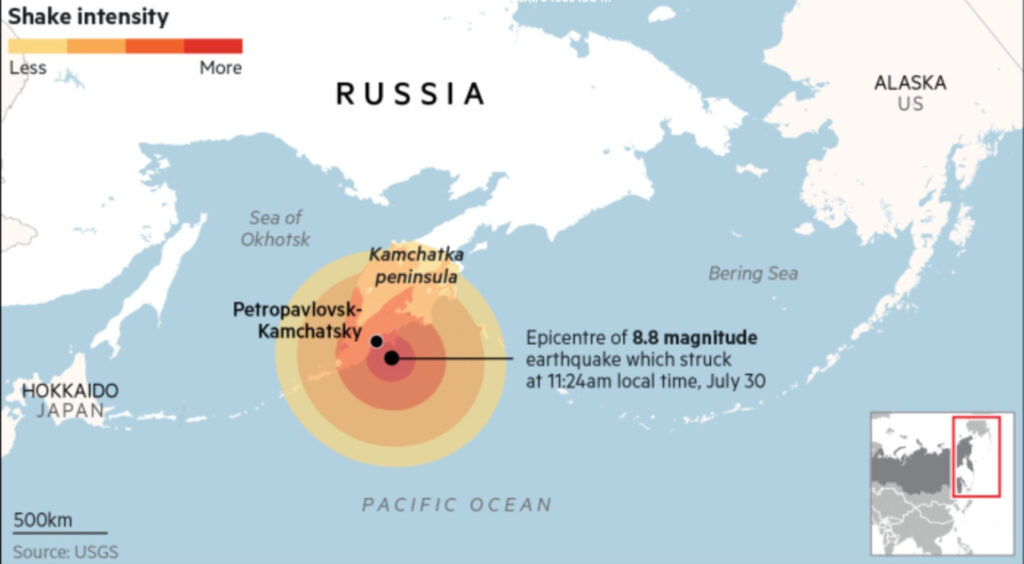On July 30, 2025, a powerful magnitude 8.8 earthquake struck Russia’s Kamchatka Peninsula, shaking cities, triggering tsunami warnings, and leaving communities on edge. This major geological event is one of the strongest earthquakes in Russia in decades and has drawn international attention due to its potential for widespread impact across the Pacific region.
🌍 Where and When It Happened
The earthquake occurred around 119 km southeast of Petropavlovsk-Kamchatsky, a city located in Russia’s Far East. It struck at a depth of around 19–21 km, making it a shallow earthquake, which typically causes more intense shaking on the surface. The time of the quake was around 2:45 PM local time.
🔬 What Caused the Earthquake?
The region sits on the Pacific Ring of Fire, one of the most seismically active areas on Earth. Specifically, this earthquake occurred along the Kuril-Kamchatka Trench, a subduction zone where the Pacific Plate is being pushed beneath the North American Plate.
This type of boundary is known for generating some of the world’s largest earthquakes and tsunamis. The energy released was equivalent to thousands of atomic bombs.
⚠️ Tsunami Alerts Across the Pacific
Shortly after the quake, tsunami warnings were issued for:
In Severo-Kurilsk and other parts of Kamchatka, tsunami waves of up to 4 meters (13 feet) were recorded. In Japan, waves of 1 to 1.7 meters reached the northern coastlines, prompting evacuations.

Luckily, while waves did hit multiple coastlines, no major casualties were reported from the tsunami.
🏚 Impact on Communities
The earthquake caused:
Cracked roads and damaged buildings in Petropavlovsk-Kamchatsky
Power outages across parts of the region
Partial flooding in fishing ports
Panic among residents as buildings swayed violently
One of the most inspiring stories to come from the event was that of a group of surgeons who continued performing an operation despite the violent tremors. They completed the surgery safely and were later honored for their bravery.
📊 Historical Comparisons
This earthquake is being compared to:
1952 Severo-Kurilsk Earthquake (Magnitude 9.0) – Over 2,300 people were killed by a tsunami.
2003 Tokachi Earthquake (Magnitude 8.3)
2011 Japan Tōhoku Earthquake (Magnitude 9.0) – One of the deadliest tsunamis in recent history
Kamchatka has a long history of powerful earthquakes due to its location on a tectonic boundary.
🌐 International Reaction
Global seismological centers and tsunami warning systems were immediately activated. In the United States, the Pacific Tsunami Warning Center tracked the wave propagation, and Japan’s Meteorological Agency issued nationwide alerts.
Governments across the Pacific basin praised the coordination and readiness of local authorities, which prevented a larger disaster.
🛠 What Comes Next?
Aftershocks are expected to continue for weeks. Some may reach magnitudes of 6.0 or higher.
Engineers are assessing infrastructure safety, especially in older buildings.
Scientists are using the event to update tsunami models and study megathrust faults.
✅ Key Takeaways
Factor Detail
Magnitude 8.8
Location Southeast of Petropavlovsk-Kamchatsky, Russia
Depth ~19 km (shallow)
Tsunami Height Up to 4 meters in Russia, 1.7 meters in Japan
Deaths No confirmed fatalities as of now
Notable Story Surgeons performed operation during the earthquake
Historical Comparison Strongest since 1952 Severo-Kurilsk event
📢 Conclusion
The Russia Kamchatka earthquake of July 2025 is a reminder of the raw power of nature and the importance of being prepared. Although major destruction was avoided, the event shook an entire region and showed how quickly life can change when tectonic plates shift.
As aftershocks continue and studies are conducted, the focus now turns to strengthening infrastructure, improving tsunami warning systems, and learning from the resilience shown by the people of Kamchatka.
